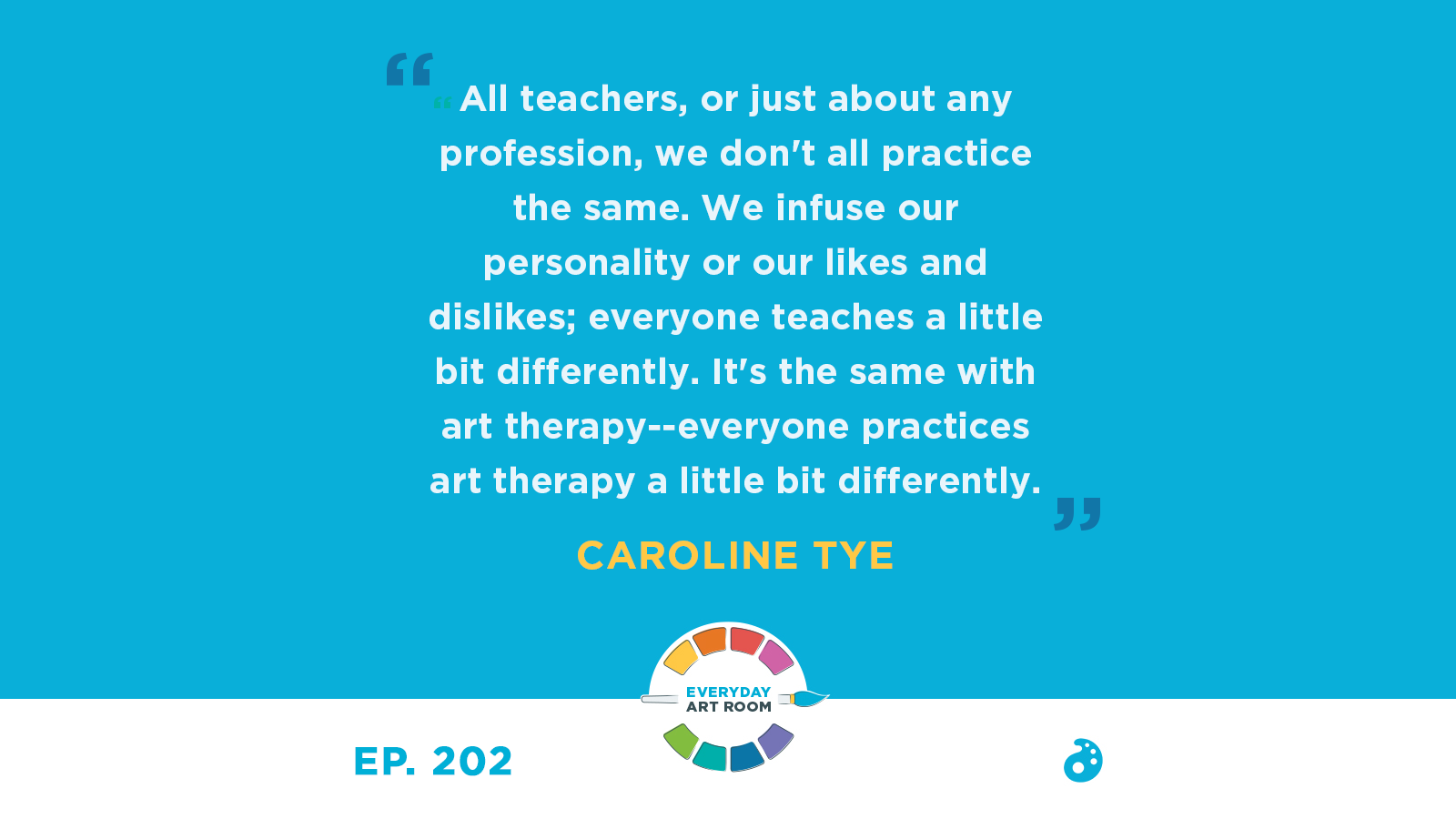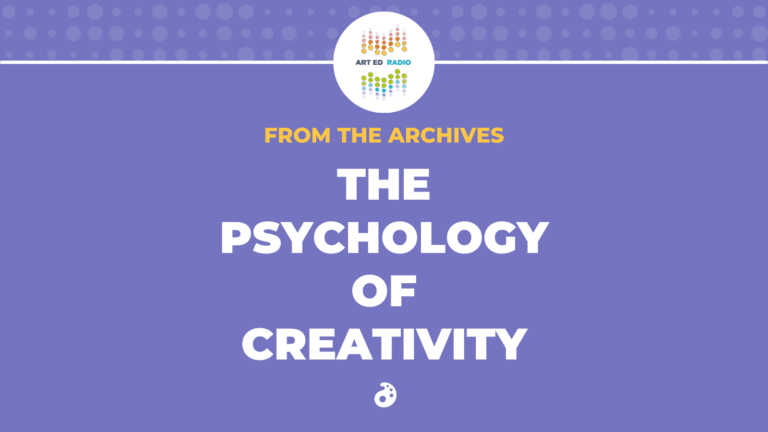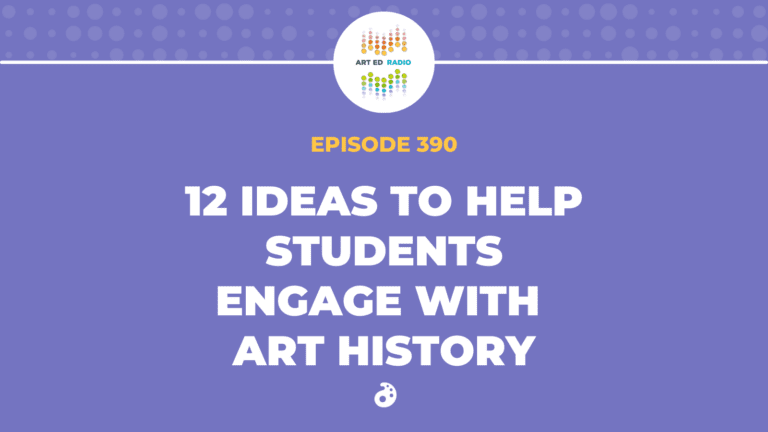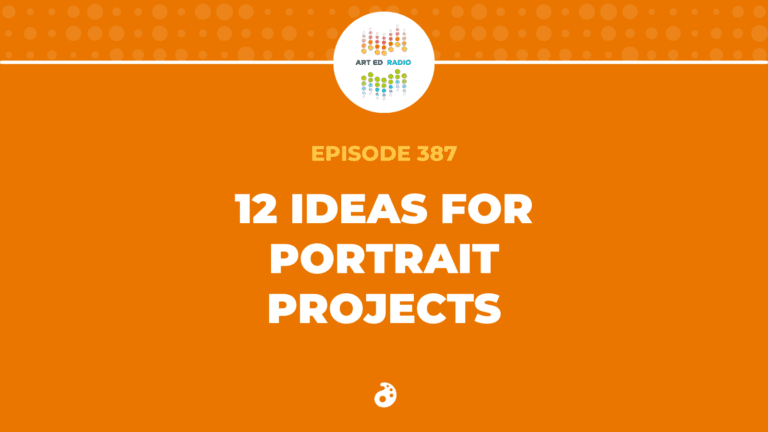As social and emotional learning becomes more important in our classrooms, many art teachers have wanted to explore art therapy. In today’s episode, Nic talks to art therapist Caroline Tye about what art therapy is, what it is not, and what art teachers need to know about the practice. Full Episode Transcript Below.
Resources and Links
- View the Art Therapy Basics PRO Pack
- Bringing Art Therapy Techniques Into Your Practice
- Learn about the Art Therapy for Art Teachers graduate course

Transcript
Nic: Today, we’re going to talk to Caroline Tye. She is an Art Therapist. She’s going to tell us a little bit about what art therapy is, and what it is not. She’s also going to give us a little bit of insight of how we can put therapeutic ideas into our classroom, and give us some really good art teacher-specific ideas about art therapy. It’s just a really great conversation. I’m very excited to introduce you to Caroline. This is Everyday Art Room, and I’m your host, Nic Hahn.
Hi Caroline, thank you so much for joining us today. I just wanted to give you the opportunity to first introduce yourself; where you’re from, what your background is, if you could.
Caroline: Yeah. So my name is Caroline Tye. I’m a Licensed Clinical Professional Counselor and Board Certified Art Therapist. Right now, I reside in Chicago, Illinois, and have a private practice there with a couple other art therapists. I guess a little bit about my background and who I am; I can’t leave out that I’m a mom of two, so I have a little girl, Olive, and a son, Leo. Olive will be one in literally a week, if you’re listening to this podcast in July. So, she will be a week; and then Leo will be four years old in October. So, they have a lot of inspiration and creativity, and things that they have added to my practice and my understanding of being an Art Therapist. So I can’t leave out being a mom, a wife, a sister, a friend; and I also am an artist myself. So I am an Art Therapist, but I practice art making for my own personal growth and understanding of myself, as well as just kind of having fun. So, that’s a little bit about who I am.
Nic: Do you have certain mediums that you enjoy?
Caroline: You know what? I love it all.
Nic: Yeah.
Caroline: So back in the day, if you were to ask me when I was a high schooler, I would say clay all the way. I loved getting my hands dirty in clay and doing 3D work, but now it’s anything that I can do. So, knowing as we all are moms, or if you have kids, or you just have a hectic life in general, and you have an art practice, you reach for anything that’s easy to do, and less, you can get it done. So it might be something like watercolors or collage or doodling, or I catch myself coloring coloring sheets sometimes, because that’s the time that I have, and what I can do. So my art making really ranges due to my time, what I’m feeling, what I’m thinking, and also my clients, and the way that they’re working in the art therapy practice.
Nic: Yeah. That sense. Absolutely. Now, just so we all know, can you give us an overview of what art therapy is, and maybe more importantly what it is not?
Caroline: Sure. I could try.
Nic: Yeah.
Caroline: I can’t speak-
Nic: Well, in a nutshell, here you go. Go.
Caroline: Let me see how concise I could do this for you guys. Right? And I want to do say, starting this podcast off, not all art therapists practice the same way. So you’re seeing the lens, and you’re hearing what I do in my studio, in my work. Some art therapists might be like, “No, that’s not really the way I practice.” I like to think of it as you guys are all art teachers, probably, most of you who are listening to this podcast.
Nic: Many. Yep. Many.
Caroline: A bunch of you guys; or the teacher, or just in any profession, we don’t all practice the same. Right? We might have that umbrella, but we maybe infuse our personality or our likes and dislikes; so everyone teaches a little bit differently. Everyone practices art therapy a little bit differently.
Nic: Sure.
Caroline: But to kind of put it in a nutshell, art therapy is really… It’s a mental health profession. So we are under that mental health profession as counselors and social workers and all of that good stuff: psychiatrists, psychologists, that we’re really helping people heal through the art making process. Sometimes we do verbalization with that, but sometimes we don’t. I like to say there’s no equation to it, and I wish that there was; but how we practice it can’t be just like, “A + B = C.” It’s kind of a ebb and flow of what art therapy really looks like. That probably doesn’t answer your question.
Nic: No. You know what? For me, though, it does, especially the part where you just explained and related to us of our classrooms, and how different we all run our classrooms. So it is hard to give that a definition; but thank you for attempting, for sure.
Caroline: Okay. And I love, Nic, that you also said, “What is it not?” And I think that’s a really great thing to talk about, because a lot of people have this myth… I don’t know. They don’t understand it, right? So they think it has to be about kids can only use art therapy. That’s kind of untrue. They think maybe you can read their artwork. We’re not fortune-tellers of the art world, right? We maybe have a gut intuition that it could mean this, or let’s explore that a little bit more, for the image and what it really means. But we’re not going to tell you this is this, and that is that. “This means this, that means that.” So we’re not fortune-tellers. We work with people of all ages, all mental health issues from people who may be struggling with transition, to people who are struggling with a diagnosis of schizophrenic. So it really has a huge scope of practice, as art therapists.
Nic: Do you find that many of your clients are inclined to art, prior to coming to you? Or is it sometimes something new to them?
Caroline: Oh, that’s a good question. I think it’s both.
Nic: Okay.
Caroline: And I apologize, throughout this whole podcast, if I’m like, “It could be either.” You’re probably going to get-
Nic: Very ambiguous. Okay. I got it. No, that’s good.
Caroline: “Caroline, be quiet.” Some people just have this inkling to create; or they were artists in the past, and they knew that art really fulfilled them, and they’ve lost that sense of creativity. And then they kind of search for art therapy. I also have people who come to me because they’re like, “I’ve tried verbal therapy, talk therapy, for the last 10 years, and I’m just not getting anywhere. I’m looking for something different.” And then they want to engage in the creative process. So you really do have a wide range of why people enter art therapy. Or parents are like, “Oh my gosh, my kid is gravitating towards the arts. Maybe this will be helpful, instead of talk therapy.” So I get lots of different reasons why people come see us.
Nic: Sure. Yeah. That makes sense. Do you think that there’s certain things, art therapy wise, that teachers could implement into an art classroom?
Caroline: So that is a really good question of the ethics of art therapy, and the ethics of being an art teacher. And I think you guys, as art teachers, can implement a more therapeutic approach by not calling it “art therapy.”
Nic: Sure.
Caroline: So just kind of not getting in that sticky situation where you’re like, “Oh, I’m doing an art therapy activity.” You’re just implementing a more therapeutic approach in your art classroom; and that’s fantastic. I wish more art teachers or more teachers or more people who approach children would work that way, to have more of that therapeutic lens. But there’s so many ways to kind of revamp your curriculum, your classroom, to have a more therapeutic approach. And that’s where I would say to kind of start jotting down ideas, or thinking about, “What can I do to have a therapeutic approach for my students and my school community?”
Nic: So, what specifically… What do you think the difference other than… You’ve already mentioned some differences between an art therapist and an art teacher. But let’s just be point blank on that. What’s the differences? Why wouldn’t we want to use that term in our classrooms?
Caroline: Well, first of all, I would want to protect guys, right? So that’s definitely a legal, ethical thing to protect you guys. Don’t say you’re doing art therapy if you’re not a licensed Art Therapist. Art therapists are licensed in some states, and they’re registered in other states; but we do have some sort of a catchall for like, “Oh, this is what an art therapist is.” And you want to make sure that you have that background, that masters degree, to call yourself an Art Therapist. Simple things is… Let’s see.
I think that as a teacher, right, you, as an art educator, who has went through all of this training, and taken all of these classes, and invested yourself in this, you wouldn’t want other people going around calling themselves an art teacher, right? You don’t want the science teacher coming and saying he’s going to host our class.
Nic: Right.
Caroline: That’s just not right. He doesn’t have that training. So you don’t have the art therapist training. You might not look at it through the lens, the clinical lens, that we’ve gotten training for. You might not understand the materials. You might not understand the diagnoses, and all of that sort of DSM, if you guys know about that; that big book of diagnoses for all the mental health issues. We’re versed in that. So I would just say, you don’t want to say you’re doing an art therapy activity, just because you’re not trained that way. But you definitely can make something more therapeutic and more relatable and more meaningful to your students in your classroom.
Nic: Okay. Let’s get into that a little bit. How could someone incorporate some of those, that thought process in their classroom, when they’re developing their lessons, or processes or mediums? What are some things that we can incorporate?
Caroline: So changing, developing a more therapeutic environment, I think, is something super big. I talk about even taking a moment for yourself to do an activity of sitting down and saying, “What do I love in a safe and nurturing environment?” And then take all those things that you love in a safe and nurturing environment, and then see if those are implemented within your classroom. We know what it feels like to be in a safe, nurturing environment. Is it a color? Is it the feeling of the light? Is it what you’re sitting on? Is it the way that your furniture is arranged? We’re really talking about that atmosphere of the classroom that you’re kind of looking at. So I think that’s really important in having a more therapeutic approach. So it’s the environment, right? And then I use this kind of silly acronym of CARE; it could kind of help you. I’ll refresh my memory of CARE.
First of all, everyone should always just care in general, right? Like it’s a great word to have. Care about what we’re doing, care about our students, care about our community; and don’t forget to care about yourself too, right? We get so wrapped up in the helping profession. You guys are absolutely helpers in the world, and to make sure you take care of yourself.
But I thought of some words that go with care. So when you’re thinking of developing these more therapeutic approaches in the classroom, I think of first, “C” is making sure that you have collaboration with your clients, and compassion; so being a really compassionate person, and collaborating with them, because it’s not all about you. It’s about you and your students, and how you guys work together within an environment. A lot of times, we have kids who struggle, that they want some sort of way to assert their independence; and that’s giving them choice, within their own learning. So collaboration.
I also think about “A” for art activities. So why are you going to do this art activity? Some people forget; and they maybe are just making it for state standards, or they’ve done it every single year, and it’s just easy to pull out and to do it. But to really look at why you’re going to have that art activity, and to make it really meaningful.
“R” has three words, so I apologize. I just put them all in there.
Nic: All the “Rs”. Do it.
Caroline: It’s being respectful, relatable, and reliable. We sometimes forget that kids need that reliability from us, like having a stable adult in their lives, and some sort of mentor that they can look up to; making sure that the classroom is always reliable, right? You have the same routine; people feel really comfortable with that, right? Not throwing all these wonky things at them, and making sure that it’s definitely just a reliable place; it’s how they feel comfortable. It’s how they feel safe.
Being relatable; I do this as in my practice all the time. It’s like I have to know, or I try to know, everything that’s going on in their world. So whether it’s a video game, or it’s some sort of show they’re watching on Netflix, or graphic novel they’re reading, gosh, what’s going on in the school. Finding ways to really be relatable to kids right now is such a therapeutic approach, and we sometimes forget about that. But really making sure that we kind of insert that in the way that we talk with kids, and the way that we develop our classroom.
And of course, be respectful. They want respect from you; you want respect from them. One way to do that is be respectful to them. And sometimes they will give it back to you.
Nic: I might copy that. I like that comment, “And sometimes…” But you are right. Mutual respect has to happen before you can expect anything coming back to you, that’s for sure.
Caroline: Yes. And oftentimes, we get in this authoritative role. And there’s always going to be a power differentiation between your students and you. Obviously, we’re put in a power role, right? Even as therapists, we’re putting a power role. And we have to remind ourselves that we’re already there, and we need to give them respect just as much as they need to give it back to us. But be aware of the power role, and the power struggles, and what that feels like. Whether you’re teaching really little kids or high schoolers, and how do we give them some control and some power, and being that ethic collaboration piece, with that level of respect.
Nic: Oh, I love it. That’s really helpful. And I love that it revolves around the word care. That’s wonderful. Thank you so much for sharing that.
Caroline: You’re welcome. You’re welcome. And “E” is empathy. So put yourself in their shoes.
Nic: Oh yeah. Sorry, we didn’t get to “E” yet. Thanks. Okay. So talk more about empathy. Let’s give “E” a proper place.
Caroline: We don’t have to; we just slide that one in there. Just be empathetic. That’s all you need. You can drop “E” off of your CARE if you want to when you have a talk, and you get to where you need to go.
Nic: No, no. You know what? And actually, we have a whole podcast with Jonathan Juravich; he is doing a podcast on SELs, so Social and Emotional Learning; and there’s one whole podcast just about empathy. So if we want to learn more, we have a resource, right?
Caroline: Go to that resource for empathy, because empathy is so hard.
Nic: The hardest.
Caroline: It’s so hard, and it’s hard to teach it, and it’s hard to do it, too. Right now, we’re living in a feared world, that’s polarized. Right? And to make sure that we have empathy for someone who doesn’t see it our way. Right? And you’re going to teach it to the kids, and you’ve got to give it back to them, so that they can see that everything’s not so black and white. There’s so much gray that we live in, and as art people, it’s a great metaphor to talk with people, and allow them to kind of share that world with you, right? Like, “No, it is not so black and white. And there’s so many things in between. And you we’ve got to figure out how to live in that grey area. It’s kind of scary. It’s kind of mucky, but that’s where most of our lives are lived in, is in the grey.” ,And that’s what we’ve done in COVID right” We’ve lived in this really unknown, icky world.
Nic: So much grey. So much.
Caroline: So much grey. So make a painting of grey, and explore your own…
Nic: I just might. I’ll do that, yes. So let’s go into… We’ve talked about the things that we can do.
Caroline: Yep.
Nic: Are there things we truly, truly want to avoid, as art teachers? And we’ve kind of talked about just the word, art therapy. Is there anything else that pops into your brain?
Caroline: I would say… The first thing that popped in my brain is I guess, don’t diagnose, right? You might have a student that comes into your place, your classroom, and you may have this inkling, that they maybe are struggling with something; whether it’s ADHD or trauma, or whatever, because you see something in their behaviors, or maybe their artwork. And I would just say, just bring that up to a support system. So, bring it to your team, like, “This is making me feel uncomfortable. I’m wondering what this is. I’m not here to diagnose anything, but something is making me question it.” And I always think bringing it up to a social worker, or to some sort of supervisor, or finding ways to do that. So I would say, just make sure that you’re not diagnosing anything.
Nic: So not… Are you saying, not giving the name of what you think this looks like; just giving the facts of what you’re seeing.
Caroline: Yes.
Nic: Okay.
Caroline: Exactly. Right? You’re not saying, “I think this person has ADHD.” Right? You’re saying, “This person’s really struggling with attention; and I’m noticing that in their artwork, they’re not able to focus. I want to bring it up to the team, because I think it might be something that could really be impacting their learning in other places, and I want to know how we can better support them.”
Nic: Perfect. Yeah, that’s beautiful. And I think that is… Especially, teachers with years of experience; they can see that behavior. And in the past, that has equaled this diagnosis.
Caroline: Correct.
Nic: And so, I can see that being a habit for some people that we might have to even break. So that’s really good advice.
Caroline: And it’s hard, right? We think we know; but then, there might be something… People are so complex, right? And the more we’re starting to learn about people, the more complex they become. So it’s probably multi-layered. And so, we don’t want to label people, or put them in this box, when we don’t quite know that; because really, it could be an attention issue due to childhood trauma.
Nic: Sure.
Caroline: It could be that they’re not getting fed correctly. It could be countless things; so we don’t want to just jump to this conclusion, because we’re going to put them in that box that they might not belong in.
Nic: Yeah. Yeah. That makes sense. So, what advice do you have for teachers who want to design a therapeutic activity for their classroom?
Caroline: Okay. Let’s see. Good question. Some advice. I’d say, I guess this goes back to some of the caring, right? Find something that’s relatable to your kids in your classroom and your environment and your community. What do they want to make? You’re not just making them make… Gosh, this just has popped into my head, but van Gogh’s sunflowers, just because you want them to make van Gogh’s sunflowers, right? Why is that meaningful? Why do they want to do it? Find ways; they can do that, but find ways to connect that generation into van Gogh’s sunflowers.
Nic: Sure.
Caroline: A lot of times, we’re losing people because we’re not kind of getting onto their levels; so really make it relatable, and make it successful for kids. Kids really want to find success within their artwork. We’re seeing a lot of anxiety that’s kind of like spiraled down into this self self-esteem, self-worth issue. So I think with art teachers, finding ways that their students can really find success in their art projects is really, really important to making it therapeutic.
And I also think material-wise; what’s the material that you’re using, and why are you using it, is very important in the sense of, “I’m just getting rid of these oil pastels.” Or, “I’m using them because they’re going to be successful in this project.” And then the kids are really going to like it.
And giving them choice. So I guess the number one thing I would say, is definitely providing students some sort of choice within a grander theme or scheme, will allow them to have success, feel independent, and in the end, really help their behavior management, because they’re invested within their own project.
Nic: Wonderful. I can’t thank you enough for joining me today. That was a great conversation. I learned a lot.
Caroline: Good. Good. Thank you so much for having me. I always love talking, obviously about art therapy, and I think it’s just amazing. But I really do value all the teachers out there, and all the art teachers out there; you guys set kids up for success. And never undervalue that, right? You guys have such a meaningful job, and a big job; but I think you all are doing a great job. And learning more about art therapy is just one way to kind of help us out a little bit more, help out the students of the world.
Nic: Wonderful. Thank you.
Caroline: Thank you.
Nic: Again, thank you, Caroline, for joining us today. I learned just a ton. But let’s say that you want to go a little bit deeper. Caroline, you have done some Pro Packs with the Art of Education, correct?
Caroline: Yes. That’s correct.
Nic: All right. Can you tell me a little bit about what that looked like, and how that is definitely deeper than this conversation than we have had here?
Caroline: Yeah. So we dive a little bit deeper into some of the stuff that we just touched upon, right? But we learn more about the ins and outs of art therapy, a little bit more techniques and concrete things that you can actually do within your classroom, on some suggested activities, or things to think about going into the ethics, and going a little bit deeper into what art therapy is, and how it can kind of support the understanding of an art teacher.
Nic: Oh my gosh. I’m definitely going to check that out. That is… I always… I love all of our resources, but Pro is one of my favorites, because it is so deep, yet quick, and right to the point. And most often, you walk out of there with something to do in your classroom. And you definitely have that, correct?
Caroline: Yeah. So you’ve got those… It’s great bite-sized pieces, right; these things, these Pro Packs are amazing. And then they actually give you those “Go do it” type of activities; or “Go think about it, and transform your classroom into a more therapeutic approach.”
Nic: Wonderful. Okay. Thanks again for joining us today.
Caroline: Thank you so much. Take care.
Magazine articles and podcasts are opinions of professional education contributors and do not necessarily represent the position of the Art of Education University (AOEU) or its academic offerings. Contributors use terms in the way they are most often talked about in the scope of their educational experiences.



